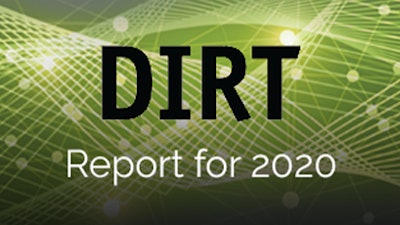
Common Ground Alliance (CGA), the national nonprofit trade association dedicated to protecting underground utility lines, people who dig near them and their communities, announced the findings from its 2020 Damage Information Reporting Tool (DIRT) Report. The report analyzed all 2020 data submitted voluntarily by facility operators, utility locating companies, one-call centers, contractors, regulators and others from the U.S. and Canada using an in-depth statistical modeling process.
The results of the 2020 analysis found that an estimated 468,000 excavation-related damages to underground facilities occurred in the U.S. last year, down from the 532,000 reported for 2019. The decrease is largely attributed to the impacts of the global COVID-19 pandemic.
Construction activity was down 4.2% in 2020 from 2019 as measured by construction spending and adjusting for steep inflation in building materials and supplies that occurred in 2020, according to the report’s analysis. In addition, the overall emphasis on safety as a result of the global pandemic may have led to less crowded and potentially less distracting jobsites, leading to an overall reduction in damages from the year prior.
While estimated damages in the U.S. decreased in 2020, the report depicts a five-year trend in damage rates that has plateaued. The 2020 DIRT Report predicts the next few years will bring an increase in construction activity and the potential of a national infrastructure program that will require the damage prevention industry to focus its efforts on addressing the consistent rate of damages and estimated $30 billion in societal costs incurred as a result of damages to buried infrastructure each year.
The 2020 DIRT Report analyzes the root causes of reported damages and finds that out of 26 possible causes, the top five damage root causes reported in 2020 made up nearly 70% of the total damages reported. The Report also notes the consistency in top damage drivers year-over-year, indicating persistent and prevalent issues, and recommends that damage prevention programs examine how they are addressing these specific root causes:
- failure to notify 811
- failure to pothole and/or maintain clearance
- facilities not marked or marked inaccurately due to locator error or the presence of an abandoned facility
The 2020 DIRT Report suggests that targeting improvements in the handful of persistent root causes may yield dramatic overall reduction in the number of annual damages to buried facilities.
Several additional recommendations for the damage prevention industry are provided, including capturing more granular data on reasons for not notifying 811, addressing damages due to faded or lost marks that occur early in a project, and utilizing the DIRT Interactive Dashboard to explore damage data pertinent to a specific organization, industry or region. Additionally, the report recommends that one-call centers explore utilizing common data collection, reporting processes and metrics for late locates to understand how varying state requirements impact ticket volume.
“As the only comprehensive accounting of underground utility damages in North America, the DIRT Report is a crucial tool for understanding the most pressing challenges in damage prevention – and to truly make progress on addressing the handful of damage root causes that are driving the vast majority of damages,” said Sarah K. Magruder Lyle, president and CEO of CGA. “With the potential of significant infrastructure legislation becoming law coupled with an expected increase in construction activity in the coming years, we must focus on the challenges outlined in the DIRT Report and work together as an industry to improve each step of the damage prevention process. In addition to reading the Report, I encourage all damage prevention stakeholders to visit the DIRT Interactive Dashboard to explore the data most relevant to your industry and geography, and understand the steps your organization could take to help reduce damages.”
The complete DIRT Annual Report for 2020 is available for download at www.commongroundalliance.com, and stakeholders interested in submitting data to the 2021 Report or establishing a Virtual Private Dirt account should visit the DIRT site at www.cga-dirt.com.



















